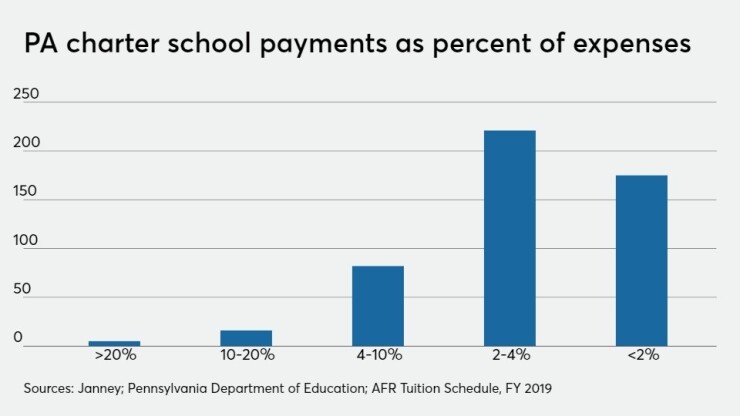The COVID-19 pandemic is accelerating funding risks to Pennsylvania public school districts from online charter schools, because of the commonwealth’s method of funding charter schools, said a
Pennsylvania has a developed public online charter option that it offers at no cost to students who choose to enroll. The resident district pays the charter a per-pupil rate.

“While traditional public school educated 89% of Pennsylvania students in 2020, cyber-charters could take away some market share [and revenue] from districts or brick and mortar charters because of schools shifting to virtual learning instead of in-person instruction since the coronavirus,” said Janney managing director Erin Ortiz.
“A shift to cyber-charter providers could occur should parents perceive an expertise in these cyber schools or are disappointed with their school’s cyber programming.”
An increasing number of the country’s largest K-12 public schools will not open with in-person instruction, including some of the largest school districts.
Other districts are pushing back start dates, offering blended learning or some type of hybrid based on student preference.
“Any can reverse course and all are susceptible to statewide public health orders,” Ortiz said. “The decision to return to the classroom is far from easy.”
School districts are generally a lower-risk municipal bond sector because revenues are fairly predictable given a high reliance on property taxes as opposed to more economically sensitive sources.
“However, there are nuances and exceptions to this, and while bondholders benefit from the commonwealth’s intercept program, understanding the underlying credit quality remains important to evaluating the true risk of a bond,” Ortiz said.
Under the intercept program, which Pennsylvania authorized in 1949, the commonwealth withholds aid due to the district and diverts that aid to bondholders should a district fail to meet its debt service obligations.
Pennsylvania school districts have a “relatively large” amount of debt outstanding statewide, according to Ortiz, totaling nearly $23 billion across 466 districts.
“Many school districts are highly rated, as seen in the exhibit, or in a sound position to manage the financial risks stemming from the virus,” she wrote. “Unlike higher education or K-12 private schools, revenues for public school districts are not tuition driven nor are seen as competitive enterprises.”
Pennsylvania is among the states with a sizable charter school option. Supporters promote the importance of school choice while opponents say it siphons funding from traditional public schools.
Most states have charter school laws. According to the Education Commission of the States’ January review, only Montana, Nebraska, the Dakotas and Vermont do not.
While most states have public charter schools, few have public online charter schools. Pennsylvania’s first such virtual charter began operating in 2003. During the 2019-20 school year, Pennsylvania charters enrolled 146,556 students, of which 26% were students at online charters.
Brick and mortar charter schools are geographically concentrated in the state, with the majority serving the Philadelphia and Pittsburgh areas.





